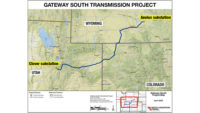Western Transmission Project Slow to Advance

An Obama administration effort to expedite federal agencies' review of the proposed 300-mile, 500-kV Boardman-to-Hemingway transmission line through parts of eastern Oregon and southern Idaho has had both positive and negative effects on advancing the project, according to Idaho Power, the utility that started planning the project several years ago.
Doug Dockter, manager of 500-kV projects at Idaho Power, says the Boardman-to-Hemingway line, generally referred to as B2H, would help several utilities in the Pacific Northwest make optimal use of the region's hydroelectric, natural-gas-fired and other generation and delay the need for adding new gas-fired capacity.
PacifiCorp, a regional investor-owned utility (IOU), and the federal Bonneville Power Administration are now partners on the B2H project, which Idaho Power initially planned to build and energize by 2012 but now is unlikely to be completed before 2020.
While B2H would largely follow existing transmission corridors, local residents raised concerns about the high-voltage project's effect on agricultural lands and environmental resources. Federal agencies and environmental groups also have cited B2H's potential impact on the sagebrush habitat of the greater sage grouse. The bird is on the U.S. Fish & Wildlife Service's list for potential Endangered Species Act protection.
Idaho Power first identified a need for additional transmission capacity in 2000 and initiated the project in 2007. The next year, the IOU notified federal agencies and Oregon's Energy Facility Siting Council that it was seeking their approval for the line; no approval is needed from the state. But while the Obama administration appointed, in October 2011, a so-called Rapid Response Team for Transmission (RRTT) to streamline federal permitting, says Dockter, "there's not even a draft environmental impact statement out yet."
Dockter says the RRTT "has given the B2H project a voice in Washington, D.C., and the team's involvement recognizes the project as being important." Still, says Dockter, "I haven't seen a direct, positive impact" from the RRTT aside from improved communications among the nine federal agencies involved in the project's NEPA review.
In fact, says Dockter, the Bureau of Land Management's role as the lead federal agency in the project's review may be a hindrance. He explains that BLM's organizational structure is highly decentralized, and there is "no one with the authority to make decisions."
Lucas Lucero, senior adviser at BLM, defends the federal agencies' efforts and the RRTT. "We use an interdisciplinary approach, with teams of specialists in various field offices that review [elements of the B2H project and their impacts] and make recommendations that filter up to the project manager, who coordinates the overall effort." Lucera notes, "These linear projects bring with them a lot of challenges, environmentally speaking, because they pass through a lot of jurisdictions," each of which may have localized concerns.






